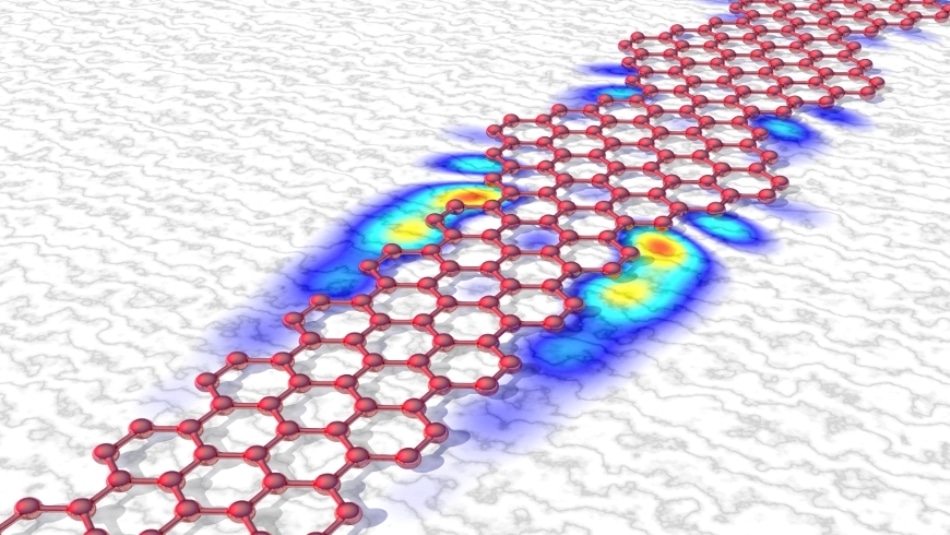Aug 10 2018
 When graphene nanoribbons contain sections of varying width, robust new quantum states can be created in the transition zone. (Image credit: Empa)
When graphene nanoribbons contain sections of varying width, robust new quantum states can be created in the transition zone. (Image credit: Empa)
Researchers at Empa have worked together with collaborators from the Max Planck Institute for Polymer Research in Mainz and other partners to accomplish an advancement that could be applied for developing precise nanotransistors in future or, in the distant future, probably even quantum computers, as reported by the team in the latest issue of Nature, a scientific journal.
Although the concept of a material comprising of atoms of a single element but having entirely different characteristics based on the atomic arrangement might sound strange, in reality, it is possible with graphene nanoribbons. The ribbons—with a width of just a few carbon atoms and a thickness of precisely one atom—have highly distinct electronic properties based on their width and shape: semiconductor, conductor, or insulator. At present, an international team of researchers headed by Empa’s nanotech@surfaces laboratory has been successful in precisely tuning the characteristics of the ribbons by particularly modifying their shape. This technology has a unique feature: apart from the ability to modify the “usual” electronic characteristics mentioned above, it can even be used to produce specific local quantum states.
So how does it work? A change in the width of a narrow graphene nanoribbon, which is from seven to nine atoms here, results in the formation of a special zone at the transition: since the electronic characteristics of the two areas vary in a unique, purported topological manner, a “protected” and hence highly robust new quantum state is formed in the transition zone. This local electronic quantum state can be readily used as a fundamental component to develop customized semiconductors, metals, or insulators—and probably even as a component in quantum computers.
The researchers at Empa headed by Oliver Gröning were able to demonstrate that producing these ribbons with regularly alternating zones of different widths results in the formation of a chain of interlinked quantum states with its own electronic structure due to the numerous transitions. The fascinating aspect is that the electronic characteristics of the chain vary based on the width of the different segments. This enables them to be delicately adjusted—from conductors to semiconductors with varying bandgaps. It is possible to apply this concept to various different types of transition zones—for example, from seven to eleven atoms.
The importance of this development is also underlined by the fact that a research group at the University of California, Berkeley, came to similar results independently of us.
Oliver Gröning, Head Researcher, Empa
On the Way to Nanoelectronics
High-precision nanotransistors could be produced in the future based on these innovative quantum chains, which is a basic step on the path toward nanoelectronics. The bandgap of the semiconductor governs whether the switching distance between the “1” and the “0” state of the nanotransistor is sufficiently large in reality—and the bandgap can be set nearly on demand with the help of the new technique.
However, in reality, this is not so simple: in order to ensure that the chain has the desired electronic characteristics, it is necessary for each of the several hundred or even thousands of atoms to be in the correct place.
This is based on complex, interdisciplinary research. Researchers from different disciplines in Dübendorf, Mainz, Dresden, and Troy (USA) worked together—from theoretical understanding and specific knowledge of how precursor molecules have to be built and how structures on surfaces can be selectively grown to structural and electronic analysis using a scanning tunneling microscope.
Oliver Gröning, Head Researcher, Empa
An Excursion into the Quantum Realm
Ultrasmall transistors, which are the next stop in further miniaturizing electronic circuits, are the evident application probabilities here: despite being technically difficult to achieve, in reality, electronics based on nanotransistors work basically analogous to existing microelectronics. The semiconducting nanoribbons developed by the Empa researchers would enable transistors with a channel cross-section that is 1000 times smaller compared to those typically produced at present. Yet, further possibilities can also be visualized, for instance, in the area of spintronics or even quantum informatics.
This is due to the fact that the electronic quantum states at graphene nanoribbon junctions of varying widths can also carry a magnetic moment. This could render it feasible to process information not using charge as was done earlier, but by using the purported spin—in the figurative sense the “direction of rotation” of the state. And the advancement could even reach a step further. “We have observed that topological end states occur at the ends of certain quantum chains. This offers the possibility of using them as elements of so-called qubits—the complex, interlocked states in a quantum computer,” explained Oliver Gröning.
However, it is not easy to develop quantum computers from nanoribbons—more research is needed, stated Gröning: “The possibility of flexibly adjusting the electronic properties through the targeted combination of individual quantum states represents a major leap for us in the production of new materials for ultra-miniaturized transistors.” The reality that these materials are stable under environmental conditions has a vital role in the advancement of future applications.
The further-reaching potential of the chains to create local quantum states and link them together in a targeted manner is also fascinating. Whether this potential can actually be exploited for future quantum computers remains to be seen, however. It is not enough to create localized topological states in the nanoribbons—these would also have to be coupled with other materials such as superconductors in such a way that the conditions for qubits are actually met.
Oliver Gröning, Head Researcher, Empa